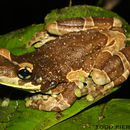en
names in breadcrumbs


The Amazon Milk frog (Trachycephalus resinifictrix) is a large hylid tree frog (males 65-77 mm, females 86-100 mm snout-vent length) that inhabits primary forests in eastern Suriname, central Guyana, French Guiana and Amazonian Colombia, Ecuador, Peru, Bolivia, and Brazil at altitudes up to 450 m asl. The nocturnal T. reinifictrix is rarely seen because it lives entirely arborally, in rain water-filled tree holes (phytotelmata) in the forest canopy at heights between 2-32 m (6-100 feet) and seldom comes to ground level. The genus so named because of a milky white secretion it makes when threatened.This species is also sometimes called the mission golden eyed-tree frog for its golden iris, with a black Maltese cross centered on the pupil; and the boatman frog, "sapo canoeiro", because its croaks sound like oars against the side of a canoe (Lima et al. 2005).Their call can be heard at Fonozoo (http://www.fonozoo.com/fnz_detalles_registro_amphibia.php?id=76136&tipo_registro=1)
From their water-filled tree cavities males make loud, broadly-broadcasting calls from their large vocal sacs on cloudless nights, to attract females. Breeding occurs mostly in the rainy season, August-September and April-June. During breeding males have nuptial pads on the insides of their thumbs.Females lay up to 2500 small black eggs in a jelly mass on the top of the water or on the walls of the cavity.Dark brown on top with light-colored bellies, the tadpoles eat algae and plant detritus and conspecific eggs (opportunistic oophagy) as they develop in the tree cavity.In captivity, the tadpoles finished metamorphosis about 10 weeks after eggs were laid.Adults are insectivores (Mignet 2015; Lima et al. 2007; La Marca et al. 2010).
Recent work revealed that T. resinifictrix included a cryptic new species, T. tschudi, also a canopy dweller and morphologically very similar, but recognizable by its distinct call frequency (Gordo et al. 2013)
Amazon milk frogs are commonly seen in zoological institutions and have been bred in captivity for decades.Mignet (2015) gives detailed description of breeding fundamentals and life stages, geared especially for zoos, aquariums and captive breeding programs.
Note: This species was previously placed within the genus Phrynohyas. Phrynohyas was recently synonymized with Trachycephalus (Faivovich, et al., 2005).
The Mission golden-eyed tree frog[2] or Amazon milk frog (Trachycephalus resinifictrix) is a large species of arboreal frog native to the Amazon Rainforest in South America. It is sometimes referred to as the blue milk frog due to a sticky, milk-like substance that they produce when feeling threatened. It was first discovered along the Maracanã River in Brazil. This species was previously within the genus Phrynohyas, which was recently synonymized with Trachycephalus.[1]
These frogs are fairly large, reaching sizes of 2.5 to 4.0 in (6.4 to 10.2 cm) in length. Adult frogs are light grey in colour with brown or black banding, while juveniles will exhibit stronger contrasts. As they age, their skin develops a slightly bumpy texture. Their blood tends to be a shade of blue which can be shown through their skin, most boldly in the mouth area and toe pads.
The "milk" in the common name comes from the milky fluid these frogs excrete when stressed.
Mission golden-eyed tree frogs inhabit humid rainforest regions. They often inhabit vegetation which extends over permanent, slow-moving water sources.
Trachycephalus resinifictrix is commonly found in captivity. They are relatively easy to care for, but require a significant amount of space, humidity, and regular enclosure maintenance to ensure a clean healthy environment for the frog.[3][4] In the wild, they live in temperatures around 21–30 °C,[3] and thus in captivity prefer a similar ambient temperature.
The Mission golden-eyed tree frog or Amazon milk frog (Trachycephalus resinifictrix) is a large species of arboreal frog native to the Amazon Rainforest in South America. It is sometimes referred to as the blue milk frog due to a sticky, milk-like substance that they produce when feeling threatened. It was first discovered along the Maracanã River in Brazil. This species was previously within the genus Phrynohyas, which was recently synonymized with Trachycephalus.